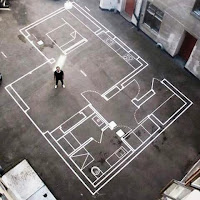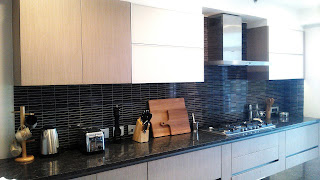 This being the festivities time here in India with Deepawali round the corner, people are busy improving, renovating, painting, decorating their homes, offices and surroundings.
This being the festivities time here in India with Deepawali round the corner, people are busy improving, renovating, painting, decorating their homes, offices and surroundings.With many of you getting your abodes painted and refurbished, here are a few tips and tricks from your friendly blog BRICKS-n-MORTAR.com that surely shall prove helpful to you.
Though you shall have employed contractors and labor to get the job done, do pay attention to these basic operations involved so as to get the best results justifying the time, money and efforts spent on your part. The key activities involved in getting one's abode painted are:
Surface Preparation
- Before application of any paint coat the substrate needs thorough surface preparation.
- Surface preparation is the first basic step before starting the painting job as the total life of any new paint job largely depends on how carefully the surface preparation is done. Paints applied on loose and flaking receiving surfaces or paints applied on greasy rusty metal substrates would give up much earlier than the usual anticipated life of the paint job.
- New wooden surfaces require scraping with sand paper to make the surface smoother, while the previously painted surfaces need removal of flaking and cracked paint film sections.
- Cement plaster surface requires wire-brushing to remove loose particles. For best finish, a layer of lime punning or plaster of paris (POP) is applied by troweling to make the surface smooth and even.
- Iron and metal surfaces require de-greasing and de-rusting before application of priming coat.
Priming
- Selection of appropriate Primer for individual substrates like Wood, Cement sand plaster, Mild Steel, Gypsum/ Fibre/ Block/ Ply boards, Aluminium etc. is important as it provides a solid base to the receiving surface before getting painted.
- Primers fight against the characteristic deficiencies related to a particular substrate (eg. Alkalinity present in cement plaster or moisture and absorption characteristic of wooden substrates)
- It protects the substrates from degradation (eg. Mild steel substrate from rust)
- Most importantly it acts as a key to provide better adhesion between the substrate and the top coat of finish paint.
Interior and Exterior Walls
- Surfaces must be cleaned, dried and freed from efflorescence
- Previously painted surfaces should be washed or brushed down but if the surface is in powdery or flaking condition, it should be removed by scraping or wire-brushing
- In case of areas affected by fungus or algae clean with wire-brush thoroughly and wash with water. After drying apply one coat of Anti-fungal solution and allow to dry
- Fill up the cracks/dents/uneven surfaces with good quality Wall Putty
- After the wall putty has dried, rub down with sand paper and wipe off the dust
- Apply 1 or preferably 2 coats of suitable Primer which acts as a good base
- Apply 1 coat of plastic paint or distemper after appropriate thinning with clean water with the help of a brush, roller or spray.
- After first coat is dry (usually 4-6 hours is sufficient) apply second coat
- In case of kitchens/bathrooms/high traffic areas, use of 2 coats of glossy or semi-glossy enamel paint is best
- For external surfaces, use of weatherproof paints are best which are moisture proof as well.
- Clean and smoothen the surface with sand paper
- Fill cracks and dents with some quality knifing paste filler
- Ensure knots are sealed with knotting varnish
- Apply one coat of Grey, Pink or White primer
- Apply 2 coats of Polyurethane, Super Enamel or Clear wood paint to give a glossy surface.
- Any signs of dirt, rust and grease should be cleaned and removed from the surfaces to be painted/ polished by using cleaning, de-rusting, de-greasing solutions or by scraping with wire-brush.
- One or preferably two coats of suitable metal primer (Red Oxide Primer or Red Oxide Zinc Chromate Primer or Synthetic Red Lead Primer) be applied and the surfaces made to air-dry.
- For aluminium and galvanised iron surfaces one coat of Etch primer be applied followed by one coat of Zinc Chromate primer before applying the desired final paint coat.
- In case glossy finish is desired on the surface, two coats of Polyurethane, Super Enamel or Clear glossy wood paint be applied in the end.
 Hope these few basic tips on home painting techniques would prove helpful to YOU. In case of any query or clarification or further information, do feel free to ask us.
Hope these few basic tips on home painting techniques would prove helpful to YOU. In case of any query or clarification or further information, do feel free to ask us.(With part references from: jensonnicholson)
------------------------------------------------------------- Found this post useful and informative? If yes, then do
SUBSCRIBE to get B-n-M's updates and feeds right there in your INBOX. Enter your email ID here ...










-718605.jpg)



gr_Floor+tiling+-+blue.jpg)

One or preferably two coats of suitable metal primer (Red Oxide Primer or Red Oxide Zinc Chromate Primer or Synthetic Red Lead Primer) be applied and the surfaces made to air-dry.
ReplyDeletethanks 4 this lovely information.. frm this information we can create a colourful and beautiful combination of colours in our home....
ReplyDeletePainting your place would be a lot easier if all the tips provided above would be followed. The given information could give you a guarantee that your painting project would last long.
ReplyDelete